
|
Sale 30
Manuscript and Collectibles Auction
| Lot |
Photo |
Description |
Realized |
Lot 1813 |
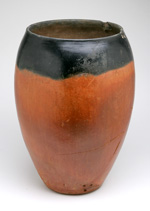 |
Very Large Black-Topped Storage Vessel. Egypt, Predynastic, Nagada II, c. 3800-3200 BC. The vessel conical, with flat base, rounded sides, and slightly everted rim. Fashioned in red-ware of deep brick red color, with distinctive black-fired top. With wonderful surfaces for age. And while large examples of this class are rare, this one even more noteworthy for having a top to bottom crack with contemporary holes as evidence of ancient repair. Amazingly, the repairs worked, as the jar has remained intact, but for a smaller piece near the base which eventually came loose. Vessel consolidated and sound, with possible traces of the original sealing of the crack. Height: 14". A most interesting archeological item.
Estimated Value $5,000 - 7,500.
View details and enlarged photo
| Unsold |
Lot 1814 |
 |
Attractive Vase in Alabaster. Egypt, 1st Dynasty, 2965-2815 BC. Elegant small vase in boldly patterned alabaster. The body conical, with sharply recurved shoulders, and small mouth with rounded rim. Evenly spaced around the shoulders are four small, pierced lug handles. Carved below these, a simulated twisted cord encircles the vessel. Some discreet, careful repairs to body, with old infilling of a cavity in the wall (about 1-3/16" 3/4"). As is often the case with this early, decorative class of alabaster bottles, the exterior surface has been carefully smoothed at some time in past century. Height: 6". "Roped" vessels are rare, and this is an especially elegant version.
Estimated Value $5,000 - 7,500.
For other examples of this class, cf. Petrie, Stone and Metal Vases, pls. VI, VII.
View details and enlarged photo
| Unsold |
Lot 1815 |
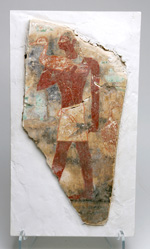 |
Rare Old Kingdom Painted Geso Fragment. Egypt, 4th Dynasty, c. 2613-2494 BC. This very rare survival is from the Tomb of Aba, Tomb 8 from the rock tombs of Deir el Gebrawi, which was published by Davies, on behalf of the Egyptian Exploration Fund, resulting from explorations carried out by him in 1900, along with earlier work by Percy Newberry for the Archaeological Survey. The quadrangular piece seen here is from the east wall of the tomb's main shrine, and shows one of Aba's servants carrying food for the banquet table of the deceased -- "(the tribute) of his tomb estate for the Ka of Aba." The man walks left, his skin a dark red, contrasting sharply against the white of his kilt. He cradles in one arm a duck, and grasps another by the wing with his lower hand. The color of the upper duck rendered in a lighter red-brown, the struggling duck of similar color, but its wings of indigo blue. The man stands against a similarly colored background, with the hieroglyphs picked out in green. This section comprised of five large pieces, set in a white-plastered frame. The gesso very well preserved for its age, with likely some discreet paint touch up here and there. The dark background a bit mottled from spots of fading. Size: 12-3/4" x 6"; Framed size: 14" x 8". Surviving gesso paintings from this period are extremely rare, even more so for examples in private hands.
Estimated Value $25,000 - 30,000.
This piece published in de Garis Davies, Deir el Gebrawi I: Archaeological Survey of Egypt, Eleventh Memoir, The Rock Tombs of Deir el Gebrawi I; Part 1 - Tomb of Aba and Smaller tombs of the Southern Group, London, 1902, pp. 23-24, pl XIX, the extreme right figure in the second register from the top. A rare original copy of this book (de-accessioned from the library of the Bishopsgate Institute) accompanies this lot. As Davis noted on p. 4, "…. The tombs lie along the low cliff in which Aba and Zau had hewn their spacious chambers, and then range themselves around a natural amphitheatre to the west, a gathering ground for the waters of occasional deluges, which have cut a deep channel down the cliff from this point." Sadly, these words would prove only too prophetic. Some years after this publication another deluge coursed through this area, destroying much of the interior of Aba's tomb, and others. Besides this fragment, two other larger pieces, also Aba's, were once in the Brooklyn Museum.
View details and enlarged photo
| Unsold |
Lot 1816 |
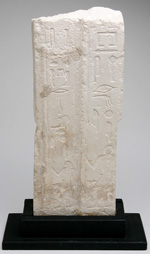 |
Attractive Early Hieroglyphic Fragment, in Limestone. Egypt, Old Kingdom, 6th Dynasty, c. 2295-2255 BC. A large fragment, comprising two vertical moldings from the right side of a false door for a mastaba tomb. On each molding, a line of neatly carved hieroglyphs: beneath each, a male (in two sizes) walking left and using a staff. The representations stylized, but done with more care than is often seen on these; with each wearing a wig, a broad collar, and a kilt with stiff triangular apron jutting forward. The inscription reads: "Ichy, Chief Lector Priest, Barber to Pharaoh Pepy I." In very fine condition, with some roughness at the top left, and some at the figure's kilts and lower. Height: 19-1/8" x 7" x 1-7/8"; on custom base. A good-sized and quite pleasing example of early dynastic Egyptian art: derived from one of the key aspects of their ritual and architectural tradition -- the "False Door."
Estimated Value $17,000 - 20,000.
Ancient World Arts, NY; the cover the piece for their 1992 retail catalog. For a complete, but somewhat later example of a false door, see C. Ede, Collecting Antiquities, fig. 227.
The 6th Dynasty oversaw the decline and final collapse of Egypt's Old Kingdom, the historical and cultural cornerstone of Egyptian civilization. From a cultural point of view, the 6th Dynasty is the continuation of the end of the 5th Dynasty. The kings still embarked on pyramid building projects, but on a smaller and more limited scale. The high mark of these edifices, in Giza in particular, was already a 150 years in the past. The interiors of this dynasty's pyramids are inscribed with Pyramid Texts, following the example set by Unas of the 5th Dynasty. Militarily and politically, expeditions and interactions with, or against, their neighbors continued, but on a reduced scale compared to the previous dynasties.
The malaise of the 6th Dynasty is believed more and more to result from climatic changes that caused a period of low Nile waters and along with it, great famine. The kings and their authority would have been discredited by this natural disaster since pharaonic power rested, in part, on the belief that the king, as a god, controlled the Nile's irrigations, and thus the country's vitality and prosperity. Especially during the extraordinarily long reign of Pepi II, the last king of the dynasty, Egypt experienced a severe weakening of the central government in which more and more power may have been relegated to, or assumed by, local administrators or governors to try and deal with havoc of the drought. Hereditary landowners attempted with some success to take control and assume responsibility for maintaining order in their own areas. For their efforts, their domains, in essence, turned into miniature courts and Egypt splintered into a number of feudal states. It would be another 100 years, with emergence of the Middle kingdom (11th Dynasty) that the central authority of the government would again begin to regroup.
View details and enlarged photo
| Unsold |
Lot 1817 |
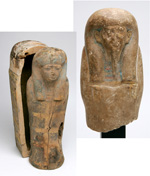 |
Lot of Two "Mummiform" Egyptian Artifacts. Egypt, Middle Kingdom - New Kingdom, c. 2000-1100 BC. From the Middle Kingdom, the upper half a large ushabti, carved in limestone. Of usual Osirid form, standing with forearms crossed, with beard and tripartite wig, and wrapped in simple, clinging shroud. The features are fine and delicate, and expertly sculpted, but have become damaged over the centuries. The stone has acquired a darkish patina over the years, but clearly visible is the remain of the paint which originally coated this piece: yellow at the hands, ears, and part of the face; blue at the wig; and along the breast, bands of red and blue, and perhaps white. At the back of the ushabti, an old inked inventory number, "1665," and what looks like an even older red and white label, inked in two lines, "117.16 / Smitts." Height: 7", on custom stand. Along with this a small wooden sarcophagus, judging by its painted decoration, likely New Kingdom, made for a "corn mummy." This coffin in essence a detailed miniature of the normal full-sized coffin. Of Osirid form, the shroud in black, with gold or yellow bands binding the figure both horizontally and vertically. The paint on the face is dark, perhaps black, the wig blue, along with bands of red and blue, and white at the breast. The coffin neatly carved, and mostly complete, but a little shaky in spots. Height: 14". Two interesting and rare objects. The large carved stone ushabti, especially, associated with high ranking royal burials. Lot of 2 items.
Estimated Value $10,000 - 15,000.
The mummy that was placed in this tiny sarcophagus was not a real mummy, but rather a figurine made of earth and grain seeds representing the god Osiris. In the ancient Egyptian religion, Osiris is the legendary ruler of predynastic Egypt and god of the underworld. He is first noted in the Pyramid Texts as a shadowy figure to which the deceased ruler is promised not to be abandoned. However, over the centuries Osiris absorbed the forms and functions of nearly all other deities associated with death and the afterlife in Egypt. Eventually he would be embodied in the "popular religion" of the people as final decision maker of one's destiny after death. In addition to these associations, Osiris was also the first born son of Geb and Nut and so embodied the "Black Land" (the fertile soil around the Nile) of Egypt itself, which yearly is "murdered by the encroachment of the Red Land (desert)," yet which returns to growth and fertility. These "corn mummies" of seeded dirt were placed in tombs to germinate in the darkness, and thus demonstrate the fecund powers of the god. Such a corn-mummy was found in Tutankhamen's tomb. Examination revealed sprouts of barley and emmer.
Such mummies should more correctly be termed "grain mummies," rather than employing the English generic usage, "corn," which actually applies to the seed of such cereals, as wheat, rye, barley, etc., rather than the maize vegetable which originated in the New World.
View details and enlarged photo
| Unsold |
Lot 1818 |
 |
Important and Rare Wall Text of Ahmose I, First Pharaoh of the 18th Dynasty. Egypt, early 18th Dynasty, c. 1550-1525 BC. The creme-colored limestone of roughly rectangular shape, containing five horizontal registers of well cut hieroglyphs. Likely a temple text, the inscription reads: "King of Upper and Lower Egypt, Ahmose I, son of Ra. / Nome of Dendera, All of the Princes of Pharaoh and Nobles…. / Seal Bearer and first friend of Pharaoh who give, Montu-Hotep, giver…. / The great wooden doors, made anew for the God Montu at Dendera / The mighty Bulwarks [damage] Amemenones I, just of voice, together with him…. Panel overall very fine, with the usual and expected damages along the edges. Size: 14" x 12" x 4"; on custom base.
Estimated Value $30,000 - 35,000.
Very Rare and significant. Only twelve inscriptions of any size are known of this important pharaoh -- sometimes referred to as the…. "Pharaoh who knew not Joseph." (Exodus I: 1-10). Ex Malter Galleries, "Collector's Journal of Ancient Art," cover piece, c. 1994.
Considered the first official ruler of the 18th Dynasty, although technically he was only a continuance of the line of Theban rulers (17th Dynasty) who had been campaigning against the foreign rulers of Egypt - the Hyksos, Semitic invaders who had control of the country for over 100 years. However his rule oversaw the final expulsion of the Hyksos from Egypt and the consolidation of his dynasty's control over the Nile Valley and adjacent areas. This effected a complete revival of the power Egypt had formerly enjoyed during the Middle Kingdom, and this achievement is thus considered the start of a new epoch. Helping to fuel this revival, Ahmose, after dealing with the Hyksos, immediately set to securing Egypt's frontiers against further intrusions. In the process he traveled south to deal out retribution to Nubia, and in crushing their king, seized the opportunity to take control of some of the richest gold mines of the ancient world. These proved immensely useful in firmly entrenching the 18th Dynasty.
View details and enlarged photo
| Unsold |
Lot 1819 |
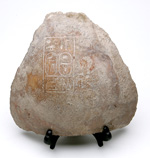 |
Fragent of a Funerary Jar, belonging to the Famed Thutmose III. Egypt, 18th Dynasty, c. 1479-1426 BC. Inscribed within a rectangular register, the praenomen and nomen, Menkheperre Djehutymes (due to the later of Greek transcriptions, Djehutymes is usually rendered as Thutmose or Thutmosis), and other glyphs, of one of Egypt's most famous kings. The fragment, of triangular shape, from the shoulder of a large jar of alabaster. The stone now a brown color, with encrustations on the exterior, while the interior surface has taken on the almost fleece-like crystalline texture of the alabaster. This jar would have been an adjunct to the canopic jars that would have held the dead king's internal organs. Leftovers that didn't fit into those jars, plus other materials and residues involved in the enbalming, all of which were too sacred to be left lying around, would have been placed in this and similar jars. Piece overall in very fine condition. Size: 7" x 7-7/8". A large and fascinating artifact of one of Egypt's greatest pharaohs.
Estimated Value $3,500 - 5,500.
Thutmose III was the son of Pharaoh Thutmose II and Isis, a minor concubine. Upon the death of his father in 1458 BC, Thutmose III became ruler. However, he was still a minor and so was forced to share power from the beginning of his reign with Hatshepsut, his father's wife, who acted firstly as regent and then later as the dominant co-ruler. For approximately 22 years Thutmose III had little power over the empire. Despite the fact that his step-mother ruled most of his early years, Thutmose III still proved to be one of the longest-reigning rulers in Egyptian history - ruling for more than 30 years beyond the time of Hatshepsut. Obviously some hard feelings arose between Thutmose III and his step-mother. As sole ruler, the newly crowned pharaoh quickly set about eradicating any hint of her reign -- erasing images, names, destroying statues, removing any references to her. Thus surviving evidence of her is fairly scarce.
He was one of Egypt's most active, expansionist rulers -- for which he is sometimes referred to as the Napoleon of Egypt. He engaged in a total of 17 known military campaigns, and was recorded to have captured around 350 cities during his rule. In addition to Syria and Nubia, he conquered much of the Near East. From the wealth of his conquests, he constructed many great buildings and obelisks throughout his empire. These building projects were often vast, thus his rule left a great impact on Egypt, both as a nation and as a culture. His influence was such that he was admired and revered for generations after. Nevertheless, Egyptologists found his tomb is very damaged state. Early tomb-robbers, in their frenzy to find the treasure, threw the burial objects against the wall, often with such force that traces of gold foil from the artifacts were found still adhering to the tomb walls.
View details and enlarged photo
| Unsold |
Lot 1820 |
 |
Amarna Relief Showing Two Servitors. Egypt, 18th Dynasty, Reign of Akhenaton (1352-1332 BC.), c. 1350 BC. The creme white limestone encompasses the juncture between to registers, with a broad horizontal band separating the two. The main device in the lower is that of two of the King's servitors left, bowing low. The further servant indicated with only a narrow profile outline, replicating that of the nearer servant. Perhaps another pair of servants bow before them. The men with relatively short wigs and white linen kilts. The best preserved of the two already shows the distinctive facial traits of Akhenaton's Amarna style, but in a more pleasing, less eccentric and exaggerated form than that which was already beginning to occur. Uncertain object seen in the upper register. The relief well preserved, and retaining much of the original coloring. The reverse side of the relief block partly rough-hewn, with remains of mortar, but the lower part clearly showing part of an inverted register of glyphs, with that of Maat being most prominent. These also hold a good deal of the original blue and red-brown paint. Size: 9" x 13" x 4"; mounted on custom stand.
Estimated Value $28,000 - 32,000.
Ex Munzen und Medaillen (Basel) Auk. 49 (6-27-74), lot 25.
It is apparent from the back side of this block that one of the techniques employed by Akhenaton to both promote his new faith, and break the power of the priests of Amun (with whom he was antagonistic to in terms of policy of monarchial absolutism) was to tear down or deface structures of that god, with the result that worked stone from those edifices, or others, was recycled for use in Akhenaton's new buildings. This was a process he engaged in quite enthusiastically. So it is not surprising that after the pharaoh's demise, and the fall of his family, that the same fate befell the structures erected by him. Large numbers of torn up reliefs from Akhenaton's monuments have been found within the walls of later 18th Dynasty structures, used as fill or bracing.
View details and enlarged photo
| Unsold |
Lot 1821 |
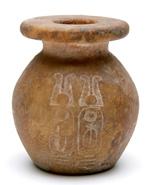 |
Alabaster Cosmetic Jar Inscribed with the Royal Cartouche of Rameses IV. Egypt, 18th Dynasty, c. 1154-1148 BC. Rameses IV: Hekamaatresetepenamun, the starting dates for his 6 year reign range around 1164-1151 BC. Cosmetic jar of ovoid form, with wide flat everted rim. Neatly fashioned in a patterned (now) tan-brown alabaster, the jar bears to two carefully engraved, crowned cartouches with an abbreviated form of his name -- Hekamaatre Rameses. Jar intact and perfect, with scattered encrustations/patina. The area surrounding the cartouches lightly and very carefully cleaned a very long ago. Height: 3". A splendid, "classically" Egyptian artifact from a short-reigned, yet notable pharaoh. Comes with hand written note, translating the name, by Professor John Callender of UCLA.
Estimated Value $7,000 - 8,000.
Rameses IV was the son of Rameses III, and was the third pharaoh of the Twentieth Dynasty of the New Kingdom era of Ancient Egypt. He survived a "harem conspiracy" which attempted to depose his father and likewise to spoil his claims to the throne. As king, he attempted a building campaign on the scale of Rameses II, but did not live long enough to accomplish his goals -- his reign lasting no more than six years.
His tomb (KV 2) was found in the Valley of the Kings and his mummy is now in the Cairo Museum. The remains indicate that Rameses was a small man, bald, with a long nose and good teeth. His tomb is rather different then most other royal tombs constructed there. Because Rameses IV assumed the thrown in a period of economic decline in Egypt, his tomb, though large, is quite simplistic, nevertheless its layout being unique in many ways. The tomb was known early on, and was frequently used as a sort of hotel by early explorers such as Champollion, Rosellini, Hay, Davis and others. It also appears to have been frequently visited in antiquity. There is considerable Coptic and Greek graffiti on the walls. Little funerary equipment is known to have been found within the tomb itself. The sarcophagus and the tomb was broken into during antiquity and the contents disturbed or dispersed.
View details and enlarged photo
| Realized
$8,050 |
Lot 1822 |
 |
Attractive Face Mask from a Coffin. Egypt, Later New Kingdom, c. 1300-1085 BC. Life-size, with handsome, idealized features, wearing a false beard and large tripartite wig. The mouth is wide, with a hint of a smile; the outlines of the eyes incised, but not for inlayed cosmetic lines or brows -- this perhaps the start of the "sfumato" style. Erosion and wear to the right side, so that only the left ear remains. Overall, very fine for wood of this age. Height: 19-1/2". A choice display piece.
Estimated Value $6,000 - 8,000.
View details and enlarged photo
| Unsold |
Lot 1823 |
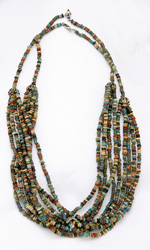 |
A Pair of Colorful "Mummy Bead" Necklaces. Egypt, 3rd Intermediate- Late Period, c. 1000-400 BC. Necklace comprised of five strands to drape below the neck, with a single strand to clasp behind the neck. Each strand made up of numerous small discoid faience beads in olives, browns, reds, a wide range of blues and greens, apple green, yellows and whites, in sultry to vivid hues. These are quality beads, and wholly real (unlike many being offered on the internet), and in choice condition. Necklace lengths: 18"-19". A good lot. Lot of 2 items.
Estimated Value $350 - 500.
View details and enlarged photo
| Realized
$460 |
Lot 1824 |
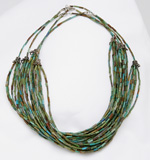 |
Another Group of "Mummy Bead" Necklaces. Egypt, 3rd Intermediate - Late Period, c. 1000-400 BC. Necklace comprised of six strands to drape below the neck, with a single strand to clasp behind the neck. Each strand made up of numerous small tubular faience beads in olives, browns, a wide variety of blues and greens, blue-greens, some cobalt and black, in sultry hues. These are quality beads, and wholly real (unlike many being offered on the internet), and in choice condition. Necklace lengths: 18"-19". Quality material. Lot of 6 necklaces.
Estimated Value $375 - 500.
View details and enlarged photo
| Realized
$570 |
Lot 1825 |
 |
"Classic Egyptian Eyes" - In Bronze and Stone. Egypt, Late Period, c. 700-30 BC. Likely from an anthropoid coffin, or perhaps a life-size figure of the god, Osiris, the bronze eyebrows are long and slightly flaring, the bronze outlines of the eyes with extended cosmetic lines. The whites of the eyes in carved calcite, the irises in black stone or paste, all in nice condition. The bronze with red and brown patina, with occasional green. Widths: 3-3/16", 3-5/16". This set an excellent group for display, of what perhaps is the most recognizable trait of the ancient Egyptian face, the outlined eyes.
Estimated Value $2,500 - 3,000.
View details and enlarged photo
| Realized
$3,450 |
Lot 1826 |
 |
A Choice Figurine of Osiris, in Bronze. Egypt, Late Period, c. 664-332 BC. The bearded god in mummiform pose, standing in form fitting robe, and holding a crook and flail in his crossed hands, with the atef crown upon his head. A tenon, for insertion into a base, can be seen underneath the god's feet. The figure finely proportioned, with precise detailing, and an exquisitely modeled face. Well preserved, with dark brown patina, showing slight traces of green. Height: 6-5/8", on custom base. Small, but exceptionally attractive! This one of the most appealing examples this cataloger has seen in some years.
Estimated Value $5,000 - 6,000.
Religion in ancient Egypt was an important part of everyday life. Priests daily attended to the needs of the gods (who were thought to be present in their cult images), and thus were instrumental in keeping order and normalcy in the world, not only of the present, but with an ever vigilant eye to the world of the hereafter also. Viewed from the outside, the ancient Egyptians were inordinately focused, if not obsessed, on the blessings to enjoyed in the afterlife. As such, the deity in charge of the Underworld would of course rank among the most worthy of worship. And so, throughout the height of Egyptian civilization, Osiris was one of the primary deities. In power, he was second only his father, Ra, who was the leader of the gods on earth.
In appearance, Osiris was viewed as a green-skinned man dressed in the form of a mummified pharaoh. He is often depicted wearing the atef crown with a pair of ram horns at its base.
Osiris was the husband of Isis, the most important of goddesses, and the father of Horus (and a number of other gods). Osiris had to reside in the underworld after being killed by his evil brother Seth, even though he was a god. Isis resurrected him with the Ritual of Life, which was later given to the Egyptians so that they could give eternal life to all their dead (this lore collected into what is colloquially known as The Book of the Dead). Osiris sits on a great throne in the underworld, where a part of the land is known as the Blessed Land. There life is like that of the living, but without sorrow or pain. An even earlier adjunct to the story of Osiris is that he was the first king of Egypt, and it was he who taught the people of about farming, and so raised them out of barbarism. In fact, they believed that it was he who gave them the gift of barley, one of their most important crops. Thus the resurrection aspect of his mythology is reiterated in his worship as a fertility god, who ensured the rebirth of vegetation each spring along the Nile.
View details and enlarged photo
| Realized
$5,980 |
Lot 1827 |
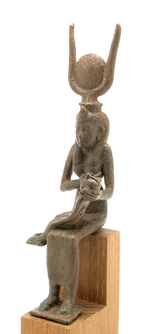 |
Attractive Bronze of Isis and Horus. Late Dynastic Egypt or Ptolemaic Period, c. 500-100 BC. The goddess seated, her feet on squarish base. She wears a uraeus cap surmounted by the Crown of Hathor and offers her breast to the child Horus held on her lap. The sculpted and chased details careful and attractive. Height, with tenon: 6-3/4"; on custom walnut base. Modest restoration to one tip of horn and edge of feet. Brown in color, the metal is sound and the figure is well-delineated.
Estimated Value $2,500 - 3,000.
Ex Superior Auction (6-2/3-98), lot 6020.
View details and enlarged photo
| Realized
$3,105 |
Lot 1828 |
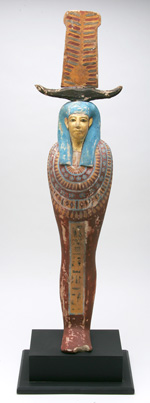 |
Sizable Polychromed Ptah-Sokar-Osiris, in Wood. Egypt, Late Dynastic, c. 500-350 BC. The beardless god in mummiform pose, in the form fitting robe of Osiris, with hands hidden beneath wide collars of beads and ornament. A lappet wig covers his head, which is surmounted by a crown of ram's horns and two feather plumes. The tall, slim figure with finely modeled face, and a panel of hieroglyphs along his legs. The figure with vivid colors: blue, dark red, the necklaces in blue, yellow and red, the glyphs black, the face gilt (perhaps re-gilt), and the crown in black, blue, red and yellow. A few age cracks visible at sides and back, a repair at knees, otherwise overall condition very good to fine. Height: 27-1/2", on custom base. An imposing and stylish wooden object of good size from ancient Egypt.
Estimated Value $7,000 - 9,000.
Ptah-Sokar-Osiris was a composite funerary god whose worship began during the Middle Kingdom period. His attributes as a resurrection deity combined those of three powerful gods: Ptah, the creator god of Memphis; Sokar, the Memphite god of the necropolis; and Osiris, king of the underworld gods. In this form he represents the three aspects of the universe: creation, stability, and death.
View details and enlarged photo
| Unsold |
Lot 1829 |
 |
Portrait Relief in Limestone. Egypt, Late Dynastic-Ptolemaic, c. 500-150 BC. Perhaps from a scene of field workers. The narrow oblong panel has the profile head of a woman right, with sweet, plumpish features, who wears a cloth covering over her hair. Behind her, a plant with ripening fruit (the apple-like mandrake?), while before her and above, part of a hieroglyphic inscription. Overall fine condition, with some wear and rubbing to parts of the attractive face. Quality workmanship, the glyphs very neat. Of interest is the ancient graffiti seen scattered throughout the unsculpted areas. Size: 10" x 25-1/2" x 2", on custom stand.
Estimated Value $8,000 - 11,000.
Ex Sloan's Auction.
View details and enlarged photo
| Unsold |
Lot 1830 |
 |
Intriguing Display of Medicine/Healing-related Artifacts. Various Ancient Near Eastern Cultures, c. 1500 BC. - 300 AD. Mounted on linen, within plexiglass box, an interesting mixture of natural objects that could have been pulverized for medicinal use, or employed ritually for healing or health, plus antiquities used for the same. Among the items from nature: a small iron meteorite, a piece of amber, fossilized horn, and an attractive piece of quartz crystal. Antiquities: 2 Roman silver-billon tetradrachms of Egypt, showing Serapis, and Horus as a canopic jar. Also, a bronze needle and implements, including tweezers, plus a small jar for ointments. The last 2 items, from Egypt, deal with revitalized life: a small ushabti, and a mold for an udjat amulet - an eye with renewed vision. A fascinating display. Framed size: 13" x 12-3/4". 13 pieces in th display.
Estimated Value $600 - 900.
View details and enlarged photo
| Unsold |
Lot 1831 |
 |
Pair of Fine Etruscan Amphora Handles in Bronze. Etruscan, circa 450 B.C. The graceful handles end in drop-shaped attachments boldly ornamented with older satyr's heads. Decorative palmettes top the balding heads embellished with flowing beards and animal ears. Height: 6-1/4", on custom lucite display stand. Beautiful even green patination; intact and superbly preserved. Lot of two.
Estimated Value $2,500 - 3,500.
Ex Superior Auction (6-2/3-98), lot 6103.
View details and enlarged photo
| Unsold |
Lot 1832 |
 |
Important Coroplast Portrait From Northern Italy. Etruscan, late 5th - 4th century B.C. Head of a woman in a micaceous orangey brown terra cotta. Her lovely, mature face is crowned by a cylindrical polos, which is covered by a veil that drapes along the sides and down behind her ears. Her hair is dressed into curls and ringlets. About her neck is an ornate necklace comprised of many amphora-shaped pendants. Head probably from a life-size votive figure. Height: 15-7/8". Chipping to tip of nose and one ear, some losses to necklace; otherwise, complete and seemingly free of repairs. Thus rare! Impressive portrait, and worthy of a premium bid.
Estimated Value $4,500 - 6,000.
View details and enlarged photo
| Realized
$4,370 |
Lot 1833 |
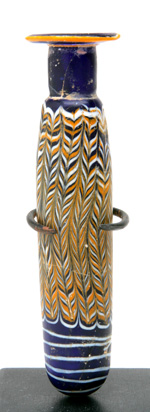 |
Colorful Core-formed Alabastron in Glass. Hellenistic Eastern Mediterranean, c. 3rd-2nd century BC. Vessel of cylindrical-ovoid shape, with a base color of fine, deep cobalt blue color, on which alternating bands of yellow, white, and blue, on the vessel's upper half, have been marvered to create intricate vertical columns of delicate feather-like chevrons. The base of the bottle with trailing white bands against the blue. Bottle carefully re-assembled from several large pieces, with light polishing of the surfaces to bring out the color. The neck and mouth are remarkably faithful restorations in glass, perhaps incorporation actual pieces from other similar ancient bottles. Height: 5-1/2"; on custom stand. The bottle nevertheless a handsome and colorful display piece of good size.
Estimated Value $1,200 - 1,500.
View details and enlarged photo
| Realized
$1,020 |
Lot 1834 |
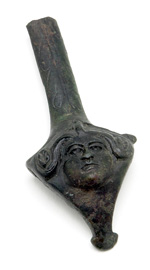 |
Attractive Maskette in Bronze. Roman, circa A.D. 1st-2nd Centuries. Base of handle from a bronze oinoichoe. The handle with incised leaf motif; at bottom, facing head of youthful satyr. His features are round and pleasant, with hair arranged like that of Cupid but with animal ears visible at sides. Length: 3-9/16". In exceptional condition with excellent modeling and an even dark patina.
Estimated Value $400 - 500.
Ex Superior Auction (6-2/3-98), lot 6117. Said to have been found in Bulgaria.
View details and enlarged photo
| Unsold |
Lot 1835 |
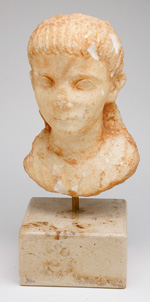 |
Attractive Provincial Marble Portrait of a Boy. Roman Egypt, c. 50-125 AD. The portrait likely from a niche, carved in high relief (about 2/3 in the round, with traces of backing at his neck. The features regular and delicate, almost feminine, of a youth aged around 7 to 10, with faint smile. Details of the iris and pupil from his eyes are not indicated, and the hair is combed forward in parallel rows, placing him in the Neronian, Flavian, or Trajanic periods. A tunic with broad fluting suggesting pleatings is seen about the neck, but with no evidence of the puerile toga. Sculpture well preserved, with minor ancient damage at nose, and a couple of recent grazes to the hair; thin reddish encrustations over much of the surface. Height: 10-1/8", on custom stand. A charming work of art, said to have been found in Egypt.
Estimated Value $15,000 - 18,000.
Ex Arte Primitivo, NY.
View details and enlarged photo
| Unsold |
Lot 1836 |
 |
Slim Figurine of Venus, in Marble. Rome, c. 2nd century AD. Carved in a fairly fine grain, somewhat translucent white marble, Venus is a slim, well proportioned maid, completely nude, and standing with her weight on one foot, leaning slightly against a short column and upright dolphin. She bends a bit forward in order to cover herself with her hands. Her head is turned a little to the side. The figure is carved with delicacy, her long torso alluring, and her face handsome, the expression slightly pensive. Condition overall very fine, with scattered remaining encrustations. Losses to one hand and one arm; repairs at the knees, with one shin being restored with marble of slightly different color and texture. Height: 12-3/4". An attractive sculpture of good quality.
Estimated Value $12,500 - 15,000.
Venus Pudica, is the name given to a version of the Venus repertoire made famous by the sculptor, Cleomenes of Athens, in the 1st century BC. Also called the modest Venus, "pudica" refers to the fact that she is using one hand to cover her private parts, while the other makes an attempt at hiding her breasts. But in an ingenious artistic slight of hand, the resultant pose is somewhat asymmetrical and more often serves to draw one's eye to the very spots being hidden.
View details and enlarged photo
| Unsold |
Lot 1837 |
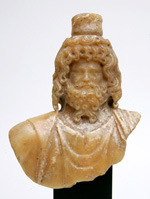 |
Choice Bust of Serapis, in Alabaster. Rome, c. late 2nd - early 3rd century AD. Portrait of the god rendered as a bust only, perhaps once atop a globe, on integral base. Serapis is shown as being rather broad-shouldered, with cloak and tunic. The distinctive measuring utensil, the modius, or kalathos in Greek, one of his attributes and a symbol of abundance and fertility surmounts his head in the manner of a crown. His hair style is very mannered, and beautifully rendered, with tasteful and decorative use of the drill (used sparingly). The Serapis here is the second of the two main portrait types -- with symmetrically arranged twisted coils of hair depending over the forehead. More interesting is the almost acanthus-pattern arrangement of five locks at the center bottom of the beard, nearly repeated with the center curls at the back of the head. His features are compact on a fairly broad face, with smallish nose. There is a glimmer of a smile in the mouth. The eyes, a trifle worn, nevertheless show the iris and pupil. Chipping to one side of the bust's forward edge, along with wear and chipping to the modius. Overall the piece is sharp, with the head and hair complete. Fine, sensitive workmanship, treated with stylistic flair. An excellent portrait! Height: 7"; on custom base.
Estimated Value $15,000 - 17,500.
Serapis was the patron god of Septimius Severus, who was the first Roman Emperor to originate from an African province (born in Leptis Magna, on the north African coast, some miles from modern day Tripoli). After 200 AD, Severus began employing the god's attributes of the forehead locks in his own hair style and official images, thus emphasizing his connection with the popular deity. Examples of Serapis portraits are also known where the features of the emperor have been conflated with those of the god. Such may well be the case with this alabaster piece. Comparing facial traits of the bust here with a sculpture of Severus in the National Museum at Naples, one sees closely similar features, and again, the bemused expression, even though this bust lacks the pendant curls of hair over the forehead. For that image type with the forehead locks, note Severus' busts in the British museum and especially the Uffizi, where the emperor's expression is again rather amiable, like that seen in the above alabaster.
The god Serapis was a Ptolemaic invention -- a fusion of Egyptian and Greek religious concepts current in Alexandria where Ptolemy I started this cult.
On his Egyptian side, Serapis was associated with Isis in his capacity as Osiris, her consort, and the Apis bull, formerly an avatar of Ptah, but later an incarnation of Osiris ("Apis was a fair and beautiful image of the soul of Osiris"). On his Greek side, he is associated with Zeus, Hades, and Aesculapius. Even though Serapis had roots in both cultures, he was always depicted as a god in the Greek manner: with the long face, heavy curled beard, a moustache with curled ends, and five locks of hair falling over the forehead. His worship continued through the Roman period and his temples spread throughout the Roman Empire, and was promulgated especially toward the military under the official patronage of the Severans.
View details and enlarged photo
| Unsold |
Lot 1838 |
 |
Group of Stone Celts. Pre-Columbian Panama, c. 100 BC. - 1000 AD. Mostly fashioned from schistose hardstones, in green, gray, and black colors, the pieces display a combination of knapping technique along with some grinding/shaping, and then polished frontal cutting edges. One piece, a hammer stone, in a basalt, ground to a narrow conical shape, with grooved waist. All intact and very fine, with the usual blemishes derived from use. Lengths: 3-5/8" - 5-1/". Lot of 5 items.
Estimated Value $400 - 500.
These objects were formerly in the collection of Panamanian dictator General Omar Torrijos, killed in a plane crash in Panama in 1981. It was with Torrijos that President Jimmy Carter negotiated the Panama Canal Treaty, returning the Canal to complete Panamanian sovereignty.
The artifacts were given by Torrijos to his secretary, who later immigrated to the U.S. and sold them to our consignor. Some photocopies of contemporary photos and articles related to Torrijos" death and funeral are included with the lot.
View details and enlarged photo
| Unsold |
Lot 1839 |
 |
Vessel with Shaman or Lord in a Hut. Peru, Viru, North Coast, c. 100 BC-300 AD. Terra-cotta, double-bodied, bridge-spouted vessel depicting a man seated in a hut. Fashioned in a deep red ware, and painted with a creme slip -- now mostly tan-brown. The man more likely a lord, for he holds a small round shield and a war club. Non-obvious repair to the handle and connector to the two vessels. Surface shows mineral deposits and some root marks. Overall, very fine condition. Height: 7-1/2"; Length: 8-3/8".
Estimated Value $750 - 950.
View details and enlarged photo
| Unsold |
Lot 1840 |
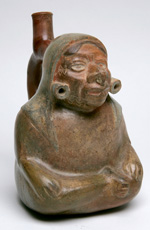 |
Interesting Seated Figure Bottle. Peru, Moche III-IV, ca. 1-550 A.D. Terra-cotta stirrup-spouted figural vessel. Seated warrior with large ear spools and facial scarification, indicated by incised designs in the clay. The man sits cross-legged, with hands on knees, and is dressed in plain short tunic and cloth head covering. The eyes and head cloth in creme slip (tending to gray in the latter); red-brown color over rest, with the face slightly redder. A little barely noticeable crack repairs, with very careful repair and restoration to part of head covering on figure's left side. Height: 7". Less common type with incise work. A fine little sculpture.
Estimated Value $950 - 1,250.
View details and enlarged photo
| Unsold |
Lot 1841 |
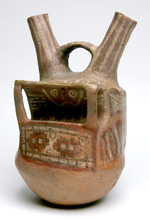 |
Colorful Vessel with Shaman in a Hut. Peru, Recuay, Northern Highlands, c. 100-700 AD. Polychrome terra-cotta, bridge- double-spouted vessel. Fashioned in a orange-buff ware, and painted with an orange slip, with patterned panels in black, red, and creme at front, sides, and back, the top and spouts in red with creme striping. Within the hut, a painted image of a seated man, rendered rather like a stick figure with large head. With typical repairs to handle and spouts, and repairs to hut supports -- otherwise vessel very fine. Height: 10-3/8". Interesting and colorful.
Estimated Value $750 - 950.
Among Peruvian ceramics, the Recuay never really developed the sophistication seen in the area's other cultures. Yet to the modern eye they nevertheless often convey a certain naive charm. Surprisingly they did excel in complex architectural vessels, often studded with multiple figures, and which are relatively common in their ceramics. Some of these may be analogous to West Mexican representations of the earthly and underworld realms.
View details and enlarged photo
| Unsold |
|
|